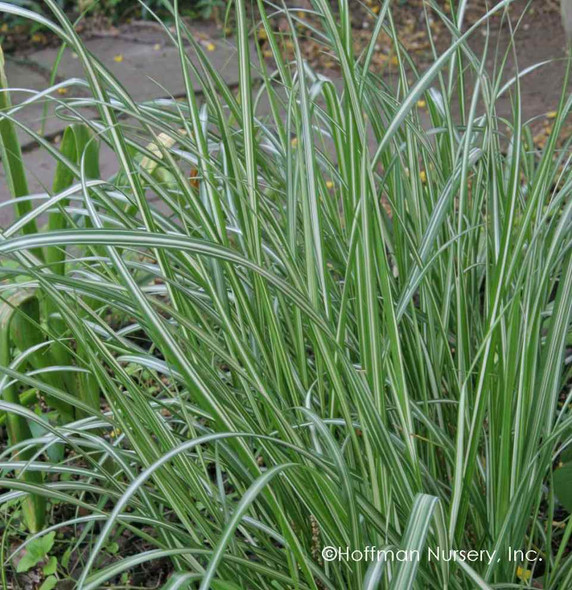Calamagrostis x acutiflora 'Avalanche' - FEATHER REED GRASS 'AVALANCHE'
'Avalanche' is similar to very popular 'Karl Foerster', a bit shorter and with white stripe in the centers of the leaves and more narrow. The whole look is more silver.
Light purple flowers from May (cool season grass), fade to "light oatmeal" color, the stripes are opposite to cultivar 'Overdam'.
Great vertical structure and very long ornamental value from May to till you cut them down.
Adaptable, drought tolerant and tough.
Blooming Time: May to late fall
Size: 50" tall x 30" wide (leaves are 24" tall)
USDA Zones: 4/5 to 8
Culture: full sun, half-sun, any soil (drier, sandy, gravely, rocky soils, clay, loam, average. Drought tolerant once established
Moisture Needs: dry, medium-dry, medium
Origin: hybrid of Asian species. Comes from division of Karl at Garden State Growers in Kettle Falls, WA ('Karl Foerster' is probably a natural hybrid between European Calamagrostis arundinacea and Asian Calamagrostis epigejos. 'Avalanche' was discovered by Steve Schmidt in Oregon.
Attracts Butterflies or Pollinators: no
Attracts Hummingbirds: no, attracts small birds
Pot Size: 3.5" x 4" perennial pot (1.22 pt/580 ml)
Picture copyright : 1 - Hoffman Nursery, 2 - Adam Woodruff Garden Design
Plant combinations: Versatile use grass - awesome in public spaces, private gardens, modern landscaping and modern architecture, but looks good in any flower bed in full sun, as a background for lower perennials, and naturalistic plantings or even cottage gardens or prairie type of gardens. Can be used in rain gardens, traffic islands. Can be combined with majority of common native and non-native perennials like Agastache, Amsonia, Aster, Asclepias, Baptisia, Calamintha, Callirhoe,Caryopteris, Chelone, Coreopsis, Echinacea, Eryngium, Liatris, Monarda, Penstemon, Perovskia, Phloxes, Physostegia, Ratibida, Rudbeckia, Silphium, Verbena, or other grasses like Schizachyrium scoparium, Sporolobus heterolepis, Stipa etc.

Calamagrostis x acutiflora 'Avalanche' - FEATHER REED GRASS 'AVALANCHE'
'Avalanche' is similar to very popular 'Karl Foerster', a bit shorter and with white stripe in the centers of the leaves and more narrow. The whole look is more silver.
Light purple flowers from May (cool season grass), fade to "light oatmeal" color, the stripes are opposite to cultivar 'Overdam'.
Great vertical structure and very long ornamental value from May to till you cut them down.
Adaptable, drought tolerant and tough.
Blooming Time: May to late fall
Size: 50" tall x 30" wide (leaves are 24" tall)
USDA Zones: 4/5 to 8
Culture: full sun, half-sun, any soil (drier, sandy, gravely, rocky soils, clay, loam, average. Drought tolerant once established
Moisture Needs: dry, medium-dry, medium
Origin: hybrid of Asian species. Comes from division of Karl at Garden State Growers in Kettle Falls, WA ('Karl Foerster' is probably a natural hybrid between European Calamagrostis arundinacea and Asian Calamagrostis epigejos. 'Avalanche' was discovered by Steve Schmidt in Oregon.
Attracts Butterflies or Pollinators: no
Attracts Hummingbirds: no, attracts small birds
Pot Size: 3.5" x 4" perennial pot (1.22 pt/580 ml)
Picture copyright : 1 - Hoffman Nursery, 2 - Adam Woodruff Garden Design
Plant combinations: Versatile use grass - awesome in public spaces, private gardens, modern landscaping and modern architecture, but looks good in any flower bed in full sun, as a background for lower perennials, and naturalistic plantings or even cottage gardens or prairie type of gardens. Can be used in rain gardens, traffic islands. Can be combined with majority of common native and non-native perennials like Agastache, Amsonia, Aster, Asclepias, Baptisia, Calamintha, Callirhoe,Caryopteris, Chelone, Coreopsis, Echinacea, Eryngium, Liatris, Monarda, Penstemon, Perovskia, Phloxes, Physostegia, Ratibida, Rudbeckia, Silphium, Verbena, or other grasses like Schizachyrium scoparium, Sporolobus heterolepis, Stipa etc.




